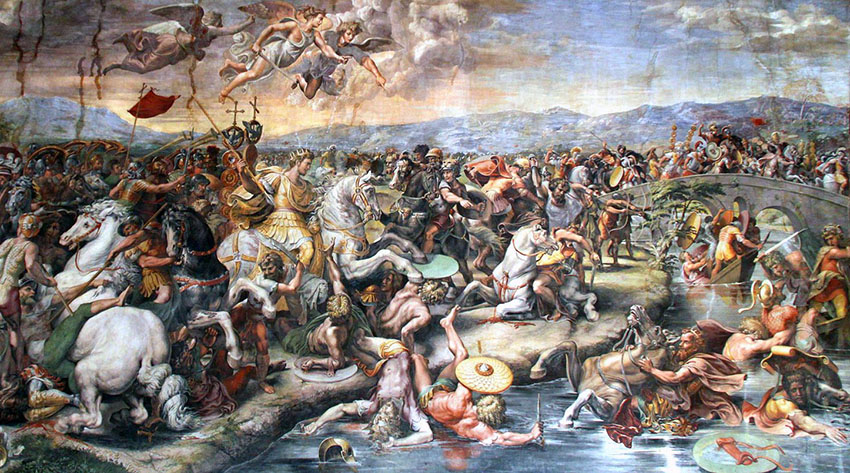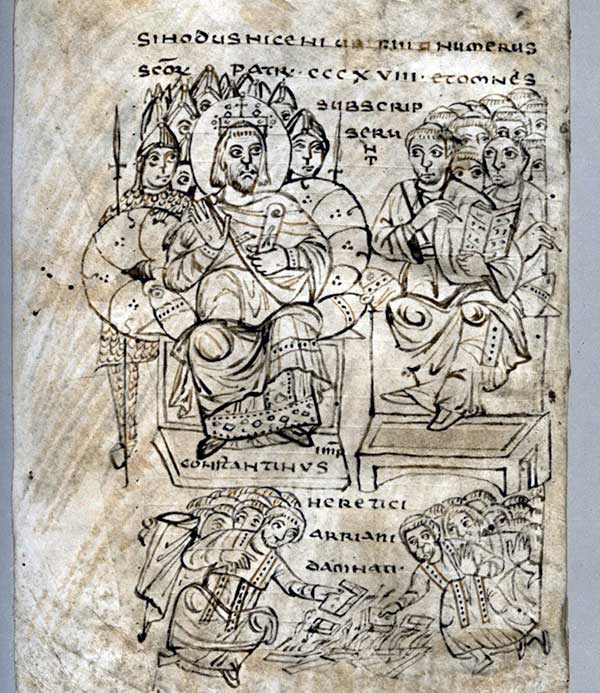Diocletian tetrarchy and peaceful transfer of power after his withdrawal from Roman throne did not go as planned. Immediately after his withdrawal from the throne, the conflict broke out between the interested roman parties. A winner of this conflict was Flavius Valerius Aurelius Constantinus Augustus also known as Constantine I, Constantine the Great or Saint Constantine which independently ruled all the way to 337 AD.
The most important changes, which occurred during the reign of Constantine I (306-337 AD) was his relation towards Christianity. According to a famous legend, when Constantine with his army advanced towards Rome, in a dream he had a vision of the cross turned towards the sun surrounded by the words: “In hoc signum vinces” (With this sign you’ll win). The next day he beat his rival Maxentius 312 AD at the Battle of Milvian Bridge, which will make him a lifelong supporter of Christianity.
That same year, in 313 AD he declared so called the Edict of Milan, a proclamation that permanently established religious toleration for Christianity within the Roman Empire. This stopped persecution of Christians. Constantine I openly helped Christianity and he even abolished the death penalty of crucifixion. He passed the Law that was valid for the whole empire. The Law ordered the observance of Sunday as a holy day. From the time of Constantine originated the first major places of worship and gathering places for Christians – the basilica. He erected great basilicas in many, for Christians holy places – the grave of the apostle Peter on Vatican hill; over the Jesus tomb in Jerusalem and in the place of Jesus’ birth in Bethlehem.
Constantine and Diocletian had the same view about one thing – that the western part of the Roman empire was no longer important and significant as the eastern part. Therefore, the East was the right place for the Emperor residence. Diocletian’s residence was Nicomedia (today Izmit in Turkey), and Constantine I was thinking about several positions for his court. First, Constantine I decided to raise his capital in Ilium – ancient Troy, even preparation works began at the site of the capital.



However, one night according to legend, God appeared to Constantine and told him to look for a better place for his new Rome. This time, Constantine turned to the European side of the Bosporus and chose the small Ancient Greek colony named Byzantium. City limes, he allegedly marked by walking with companions who had followed him anxiously and asked him how much longer he will walk, and according to the legend Constantine replied: “I’ll walk as He who walks in front of me does not stop”.
Constantine has launched a massive program of the new city construction in the record time. He turned it into the replica of the Rome, with seven artificial hills, he filled the city with treasures from other cities, and he built hippodrome, the forum, the senate building, baths, gardens, and aqueduct. The construction of the city was finished in 330 AD and it first name was New Rome but later on it was changed to Constantinople. The choice for the position of the new capital was brilliant. This was the main intersection of roads between Europe and the Middle East. The government got control over the trade position between East and West. Since the city was built on a peninsula, defense capabilities were also great, because the Navy was able to defend it from three sides, while on the land side of the city they built a defensive wall which Western world has never seen before. In this way Constantine made the city practically impregnable and the city withstand many siege for the next thousand years (until 1453 AD).
Christianity during Constantine reign
Fourth century welcomed the final triumph of Christianity in the territory of the Roman Empire. At the beginning of the century, Christians were severely persecuted, while at the end of the century it was almost unimaginable that an Emperor was a member of another religion, besides Christianity. Christianity has overcome the pagan beliefs because of its simplicity, and it gave hope to the common man, which in those turbulent times was very important. A good organization was the key in fast spread of Christianity. In each new area, Christianity stayed the same, while the pagan religions had a number of idols and myths that vary from province to province, and they are most often organized only at the local level.
Constantine’s support has made the church a lot stronger than it would be without his support. Such power of the church ensured and facilitated the imposition of uniformity in the practice of the Christian faith. Constantine’s action discouraged every worshiper of some other religion, and even disagreement with the basic doctrines of Christianity (by Christians) became a sufficient reason to declare someone a traitor and an apostate. Authorities started to use their power and force in order to promote Christianity, which until recently was used against him.
One of the most important issues at the time of Constantine’s Christianity was organization some controversy among the believers, particularly regarding Arianism. Arian was a bishop in Alexandria somewhere between 318 AD and 323 AD he began to study that Jesus Christ is not the same in the holy trinity with the Father but that he was created during period of time by God.



Arian teachings provoked anger in the East and abroad, and it polarized believers. Constantine did not want that such arguments were led in his empire, so Constantine summoned the first Ecumenical Council of Nicaea in 325 AD, which was attended by about 250 bishops from all parts of the Empire, and the council was chaired by Constantine although he was not yet baptized at that time. Council of Nicaea made a decision to reject Arianism and it was determined that Jesus Christ origin was the same as holy the Father origin was and that he was eternal as well. Only Bishop Arian and his two supporters did not accept such a decision. Arianism became heretical teachings. As Arian teaching was rejected by the official Church it primarily started to spread among the Goths who were numerous on the borders of the Roman Empire.
One of the main disseminator of the Arian Christianity among the Goths was Bishop Ulfilas, barbarian, who was brought up in Constantinople. He first met the Visigoths with Christianity, and his teaching was later spread to the Ostrogoths and Vandals. Ulfilas made it easier to spread Arian Christianity among the Goths thanks to the gothic alphabet which was created by him. He combined Greek and Roman letters with the Scandinavian runes, and with this letter he wrote the Bible for new Christian people. Since the Goths accepted Arian Christianity, in the eyes of the secular and religious authorities, but also in the eyes of the indigenous population this act made them heretics. This act made it harder to control the area, which they settled. So it was no accident that the most successful Germans were those who accepted orthodox Christianity (Franks), or they have not christened until Arianism was not eradicated (Anglo-Saxon).
